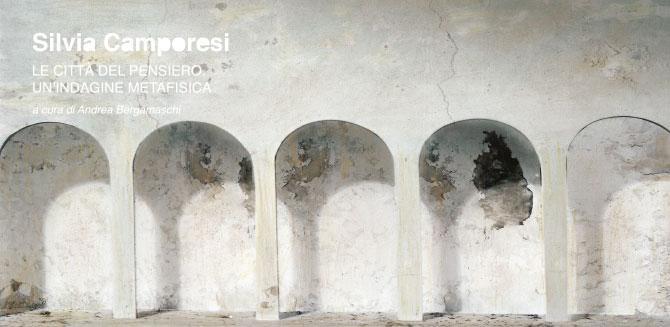Silvia Camporesi
a cura di Andrea Bergamaschi
a cura di Andrea Bergamaschi
... And if someone had commissioned the painter Giorgio De Chirico, in the '20s /' 30s of the last century, not only the umpteenth "Piazza d'Italia" but even the design of a whole new country, based on geometry and on the suggestions of his most famous paintings? ... and if de Chirico had accepted the challenge, realized the projects and followed the works as a true architect, what kind of country would have arisen?
From this game of "... and if" comes the latest work by Silvia Camporesi for the Galleria MLB in Ferrara, to which the artist from Forlì wanted to add a final and intriguing question: to imagine that the village was built, inaugurated and lived for a short time, maybe a few years, until the outbreak of the Second World War, during which the village is abandoned, the inhabitants are dispersed in other countries and in other realities, the houses are closed and no one is interested in inhabit those spaces and cross the streets, so that the historical and geographical memory loses its place. The artist wonders what could be the appearance of this country 70 years after abandonment, such as the natural metamorphosis of its spaces and its architectures so little experienced, modified and "updated" by man, but just as consumed and ruined from the elements and the seasons.
Camporesi decides to rediscover this unprecedented metaphysical heterotopia, this real and at the same time ideal place, decides to visit it on a warm misty and timeless day and get lost in its narrow streets and squares, to document its current state, trying to to recover photographically the metaphysical spirit at the origin of the project and the atmospheres that ideally accompanied for a short time the daily life of its few inhabitants.
To achieve this result, Silvia decides to go through two conceptually opposite roads: the first, already tested in her 2011 work, La Terza Venezia, is to resort to models, this time partly freely inspired by the architectures that appeared in De Chirico's paintings. (temples and colonnades, round arches, towers) and partly attributable to certain real architectural and urban solutions, among other things, surprisingly similar to the buildings painted by the painter, adopted by the Fascist government to create, in the south, several small villages of service during the last years of the twenty years.
The second road, however, widely developed in the latest work Atlas Italiae, consists of photographing abandoned real places, such as some of the above Sicilian villages, in part already inexorably reabsorbed and hidden by nature (the so-called Third Landscape of Gilles Clément).
The circle closes some shots made in Tresigallo, small and lively village of Ferrara, also considerably expanded, according to the architectural canons in vogue in the '30s, at the behest of the fascist minister Edmondo Rossoni, who was born here in 1884 Some photos of the series are printed in black and white and colored by hand, an intervention that gives a new and unprecedented life to dead places, where the infinite nuances of the plaster now corroded by moisture and swaying like fans on the long walls of empty porticoes they intertwine with the soft colors of the sky and the earth.
Never as in this work, however, it is worthwhile to overcome the easy game of fictional realism (and its opposite), of the ambiguity between true and false, between real and imaginary and, accepting the invitation of De Chirico himself, to go beyond the materiality of things, of looking through the physicality of architecture and space to perceive the ideal essence and thus abandon itself to the epiphany that only comes to those who observe "for the first time" the places that surround it.
 Title
Title
Title
Title
 Title
Title
Title
Title
 Title
Title
Title
Title
 Title
Title
Title
Title
 Title
Title
Title
Title
 Title
Title
Title
Title
 Title
Title
Title
Title
 Title
Title
Title
Title
 Title
Title
Title
Title

 Title
Title
Title
Title
 Title
Title
Title
Title
 Title
Title
Title
Title
 Title
Title
Title
Title
 Title
Title
Title
Title
 Title
Title
Title
Title
 Title
Title
Title
Title
 Title
Title
Title
Title
 Title
Title
Title
Title
 Title
Title
Title
Title
 Title
Title
Title
Title
 Title
Title
Title
Title
Finger Food a cura di Laura Saetti